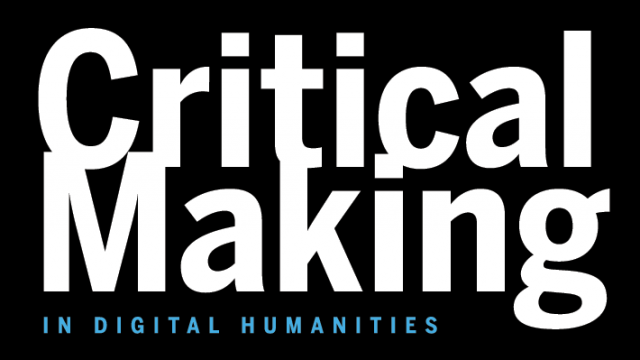“The use of the term critical making to describe our work signals a desire to theoretically and pragmatically connect two modes of engagement with the world that are often held separate–critical thinking, typically understood as conceptually and linguisticaly based, and physical ‘making,’ goal-based material work.”
Matt Ratto, “Critical Making: Conceptual and Material Studies in Technology and Social Life.” The Information Society: An International Journal. 27.4 (2011): 252-60.
Critical making “explores how hands-on productive work — making — can supplement and extend critical reflection on technology and society. It works to blend and extend the fields of design, contemporary art, DIY/craft and technological development. It also can be thought of as an appeal to the electronic DIY maker movement to be critically engaged with culture, history and society: after learning to use a 3D printer, making an LED blink or using an Arduino, then what?”
Garnet Hertz, Advertisement to Critical Making zine project.
“To Make is to Know.”
Anne Burdick, Critical Making: Manifestos. Ed. Garnet Hertz. Hollywood: Telharmonium Press, 8-9.
“While we’re acknowledging writing theory as making stuff, can we also acknowledge making stuff as doing theory?”
Matt Kirschenbaum, @mkirschenbaum, 4 Jan. 2013, 11:33 AM.
“I’ve always understood writing as an intellectual conception and material production simultaneously. I don’t think texts without seeing their format. The particulars of layout, organization, mise en page, and other structuring principles are integral to the composition even if it is a block of unbroken prose or lineated poetry. No doubt this is because I’ve made so many of my own books–design, typeset, printed, bound them–that, for me, writing is design as well as composition.”
Johanna Drucker, ‘Eye-Mind-Design-Production’: An Interview with Johanna Drucker.” MATLIT 1.1 (2013): 169-177.
“Vanguard artists, like their counterparts among academic critics, often base their projects on the important theoretical texts of the day. The difference between the two applications had to do with their respective modes of representation: the artists demonstrate the consequences of the theories of the arts by practicing the arts themselves, generating models of prototypes that function critically as well as aesthetically.”
Gregory Ulmer, Heuretics: The Logic of Invention. London: Johns Hopkins UP, 1994.
“In order to be able to address contemporary human experience, we need science and the humanities to be combined into hybrid forms which can address the machinic and the human simultaneously. Squeezed in between the disciplines, we can already see these forms developing.”
Phoebe Sengers, “Practices for Machine Culture: A Case Study for Integrating Cultural Theory and Artificial Intelligence.” Surfaces. Volume VIII, 1999.
“Whether or not the real radical philosophers march or protest or run for office in addition to writing inscrutable tomes–this is a question we can, perhaps, leave aside. Real radicals, we might conclude, make things.”
Ian Bogost, Alien Phenomenology, or What It’s Like to Be A Thing. Minneapolis: U of Minnesota Press, 2012.
“[Adversarial design] straddles the boundaries of design and art, engineering and computer science, agitprop and consumer products. It spans a range of users and falls under various labels, such as critical design and tactical media. But across the differences, there is a common characteristic. Through designerly means and forms, adversarial design evokes and engages political issues.”
Carl DiSalvo, Adversarial Design. Boston: MIT Press, 2012.
